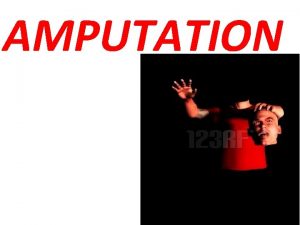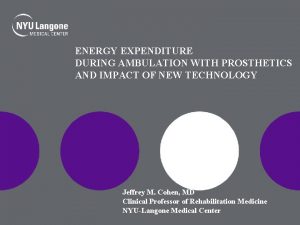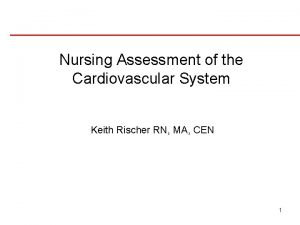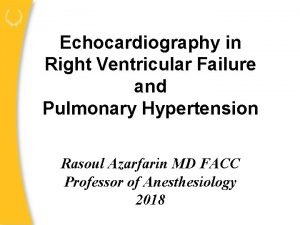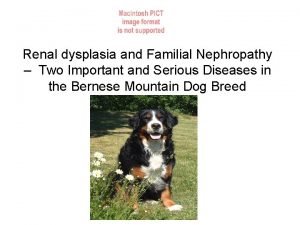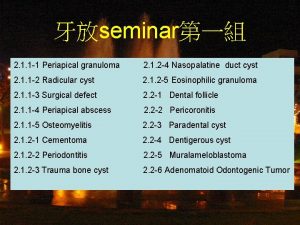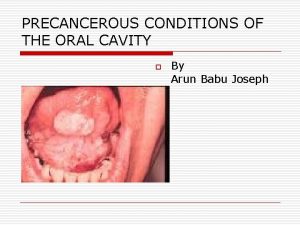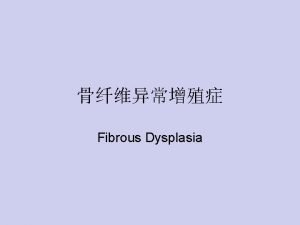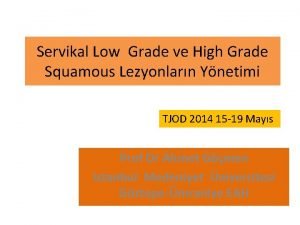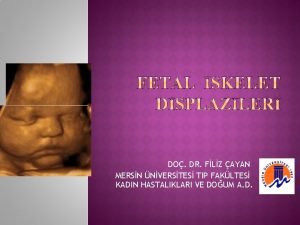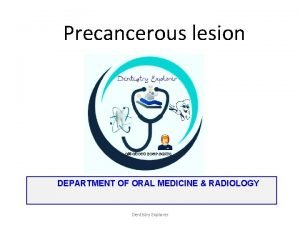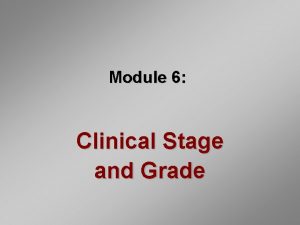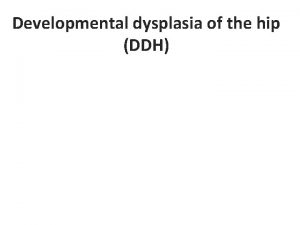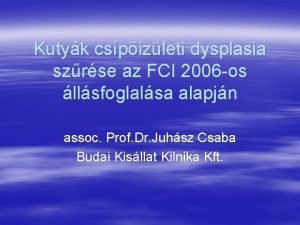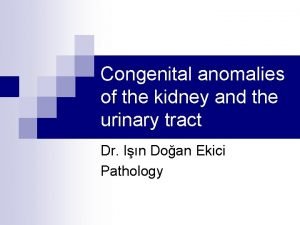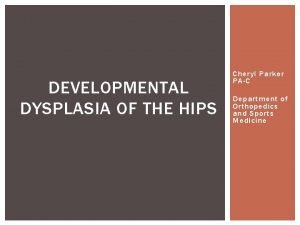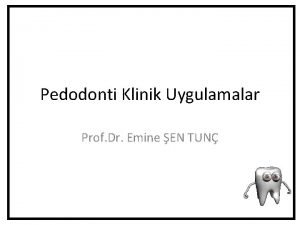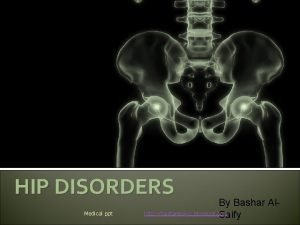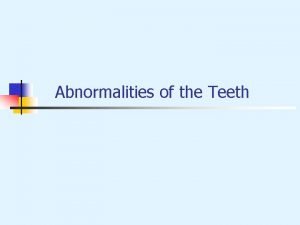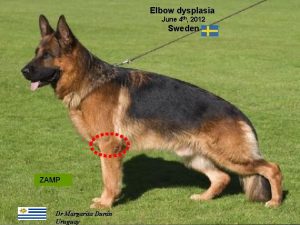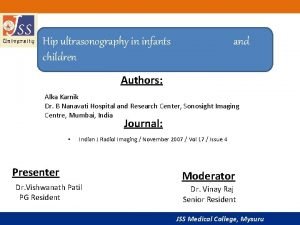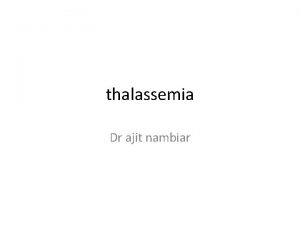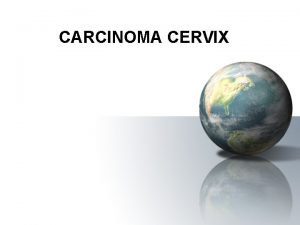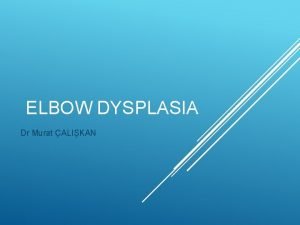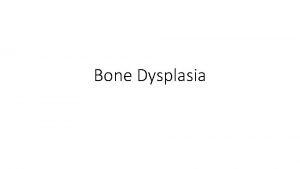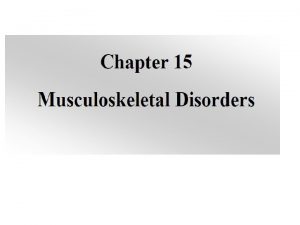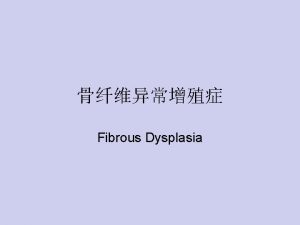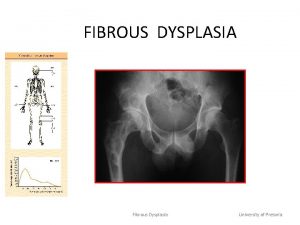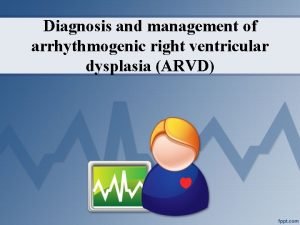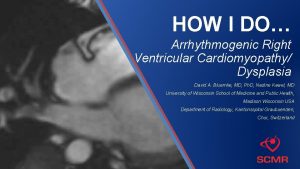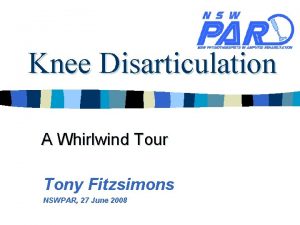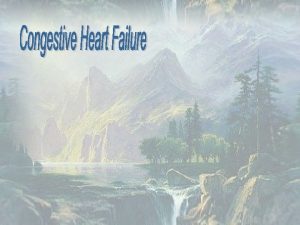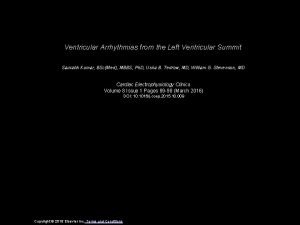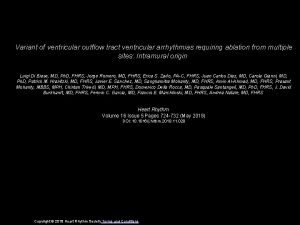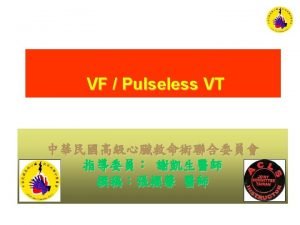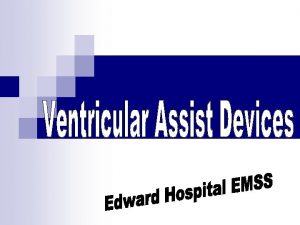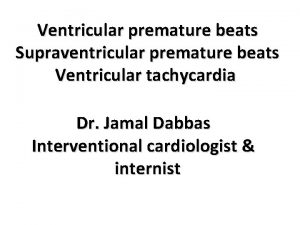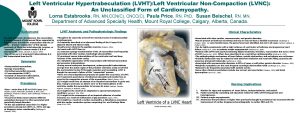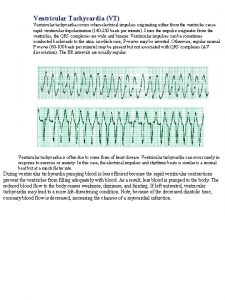Right ventricular disarticulation for arrythmogenic right ventricular dysplasia
























- Slides: 24

Right ventricular disarticulation for arrythmogenic right ventricular dysplasia: an 18 year single centre experience. J Zacharias, J Forty, C Doig*, J Bourke*, CJ Hilton. Departments of academic cardiology and cardiac surgery, Freeman Hospital, Newcastle upon Tyne. England.

ARVD • • • A Type of cardiomyopathy Affects all age groups Presentation with syncope / sudden death Ventricular Tachycardia / Fibrillation Familial occurrence Structural changes in R V Myocardium

Histology

Treatment options with ARVD patients: • Antiarrhythmic medication • Percutaneous catheter ablation • Automatic internal cardiac defibrillators. (AICD) • Surgery

Right Ventricular Disarticulation v Described initially by Guiraudon v Animal studies done by Guiraudon & Cox et al v Medium term results from Cox and Hilton et al v Few surgical reports lately

Retrospective Case series: • Institution: Tertiary referral centre : Freeman hospital. • Time Frame: July 1985 - July 2003. • Patient Numbers: 17, age range (14 - 72), 15 M / 2 F • Surgeons: CJ Hilton (14) & J Forty (3)

Pre Op Details: • Presentation: » Syncope: 12 » Intractable VT : 3 patients » Electrical storms (AICD): 2 • Management; » » » Drugs: 17 (Range 3 - 8) EPS: 17 AICD: 2 Echo: 14 Angio; 14 CT Scan: 2

Preop Echo Of ARVD patient

Operative details: • Complete: 10 • Partial: 7 • Full Cardiopulmonary Bypass • Cold Blood Cardioplegia • Induce VT in the disarticulated segment

Gross Appearance Of ARVD Heart





Completed RV Disarticulation

Post operative events: immediate I § Mortality : 1 (6%) multi-organ failure § Overall complication rate: 64% (11/17) § Reopening for bleeding: § Renal failure: § Tracheostomy: § Derangement of liver function: § Pleural effusions: 4 3 2 1 3

Post operative events: immediate II o Mean post -operative hospital stay : 17. 6 days (range 9 - 35 days) o Electrophysiological studies : 16 o Medication at discharge: ü Anticoagulation: 4 ü Antiarrhythmic drugs: 2 ü Digoxin & Diuretics: 6 o Biventricular pacing : 2

Post operative events: medium term • Further VT episodes : 4 • Partial 3/7 • Complete 1/10 • Supraventricular Tachycardia: 10

Echo findings 14 yrs post RV Disarticulation.

Post operative Events: Long Term • Follow up : 94% (15/16) – 1 lost to follow up alive & well at 5 years. • Median 13 years (range 0 - 18) • Death: 3 ( 9, 11, 17 years post op) • Transplantation: 2 ( 3, 8 yrs post op) • Awaiting transplantation: 2 ( 3, 14 yrs post op)

Kaplan-Meier actuarial survival 100 16 15 14 80 13 12 11 Survival % 60 40 20 0 0 5 10 Survival in yea rs 15 20

Discussion points: • Natural history of ARVD • Affects young patients • Biventricular failure affects some • Heart transplantation • Prevention of sudden death • Can occur despite AICD • International registry details awaited • Long term effects of biventricular pacing

Effects of Right ventricular pacing

Conclusions: • Excellent antiarrhythmic procedure • 77% event free survival at 10 years • Heart failure may be related to natural history of ARVD Consider as an option in young patients with ARVD who cannot be managed with medication or AICD
 Boyd amputation definition
Boyd amputation definition Bilateral hip disarticulation
Bilateral hip disarticulation Right product right place right time right price
Right product right place right time right price Family time
Family time Right ventricular failure
Right ventricular failure Pa systolic pressure range
Pa systolic pressure range Dog kidney
Dog kidney Periapical cemento-osseous dysplasia
Periapical cemento-osseous dysplasia Differential diagnosis of osmf
Differential diagnosis of osmf Ground glass appearance fibrous dysplasia
Ground glass appearance fibrous dysplasia Epidermal dysplasia verruciformis
Epidermal dysplasia verruciformis Diastrophic dysplasia
Diastrophic dysplasia Epithelial dysplasia oral
Epithelial dysplasia oral Epithelial dysplasia
Epithelial dysplasia Klisic sign
Klisic sign Norberg szög
Norberg szög Renal dysplasia
Renal dysplasia Breech presentation
Breech presentation Hiperdonti nedir
Hiperdonti nedir Hip dysplasia ppt
Hip dysplasia ppt Cleidocranial dysplasia
Cleidocranial dysplasia Elbow dysplasia in dogs
Elbow dysplasia in dogs Hip and elbow dysplasia
Hip and elbow dysplasia Hip usg
Hip usg Hair on end appearance skull
Hair on end appearance skull
